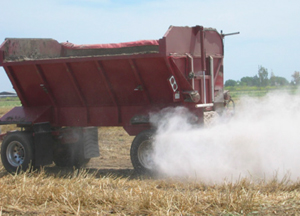Calcium carbonate, the chief component of limestone, is a widely used amendment to neutralize soil acidity and to supply calcium (Ca) for plant nutrition. The term “lime” can refer to several products, but for agricultural use it generally refers to ground limestone.
Production
Limestone is a common sedimentary rock found in widespread geologic deposits. It has been used throughout much of recorded history as a building material, a cementing agent, and in agriculture to improve acid soils. An agricultural liming material (ag lime) is broadly defined as any substance containing Ca or magnesium (Mg) and capable of neutralizing acidity. Many materials can be classified as ag lime.
Ag lime is extracted from quarries or mines and usually requires mechanical crushing. The fineness of the ag lime is important in determining how quickly it reacts with soil acidity. Limestone of a smaller particle size reacts quickly because of the larger surface area exposed to chemical reaction. Larger particles react slower, but provide a sustained, longer-term source of acid neutralization. A measurement of particle size typically appears on the product label.
Other materials in the ag lime, such as clay, will reduce its purity and diminish the acid-neutralizing capacity. Ag lime effectiveness is rated based on its comparison with pure calcium carbonate (CaCO₃), a value that is expressed as the percent calcium carbonate equivalent (CCE). Ag lime is more soluble in acid soils than in neutral or alkaline soils. The presence of CaCO₃ in soil is detected by the effervescence or “fizz” when a drop of strong acid is applied.
Agricultural use
The primary use of ag lime is to raise the pH of acid soils and reduce the concentration of aluminum (Al) in soil solution. Poor crop growth in acid soils largely results from too much soluble Al, which is toxic to the root system of many plants. Lime will reduce soluble Al through two reactions: CaCO₃ + H₂OICa²⁺ + 2OH⁻ + CO₂ and Al₃ + [soluble] + 3OH – IAl(OH)₃ [insoluble].
Additions of ag lime also supply valuable Ca (and possibly Mg) for plant nutrition. Some secondary benefits of neutralizing soil acidity with ag lime include:
-
Increased phosphorus (P) availability;
-
Improved nitrogen (N) fixation by legumes;
-
Enhanced N mineralization and nitrification; and
-
Better water use, nutrient recovery and plant performance with a healthier root system.
Management practices

Lab testers can easily determine the quantity of ag lime needed to bring a soil to a desirable pH range. Most commonly, farmers spread the lime uniformly on the soil and then mix it through the root zone. Neutralizing soil acidity is not a one-time process, however, and must be repeated periodically depending on soil and environmental conditions. Typical application rates are measured in tons per acre.
Non-agricultural uses
Limestone is one of the most widely utilized of all earth materials. In addition to its use in building and construction, limestone’s diverse applications include air pollution control, treatment systems for drinking water and wastewater, soil stabilization, medicines, antacids, and cosmetics.
Source: Nutrient Source Specifics, No. 18, International Plant Nutrition Institute